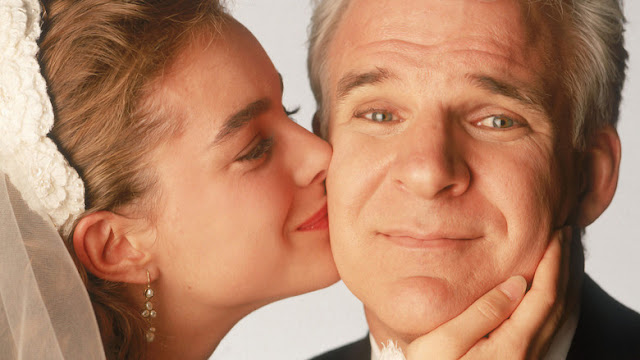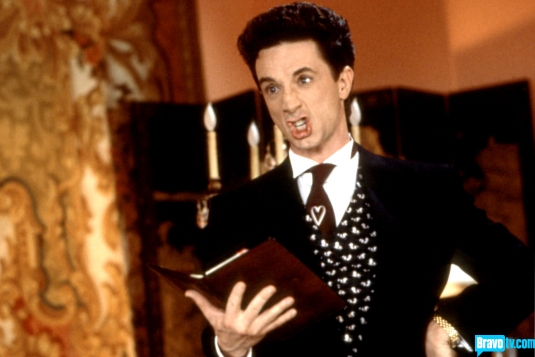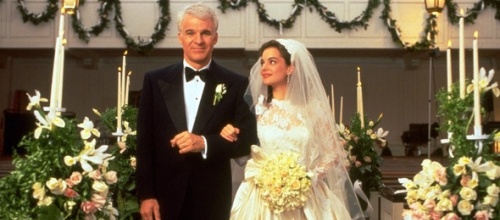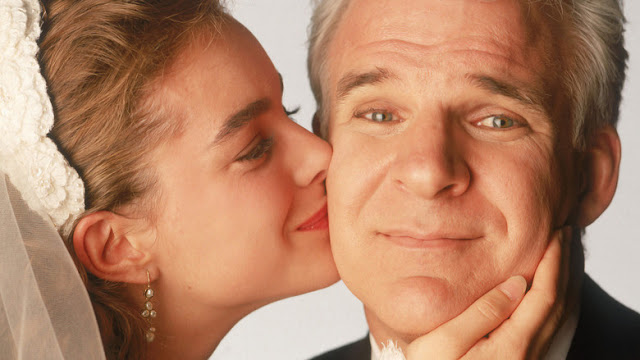 |
| Steve Martin and Kimberly Williams-Paisley in Father of the Bride |
Father of the Bride (1991) is aptly named, as its focus is not on the wedding itself or the couple involved but on the titular character’s neuroses and journey to maturity. The wedding is the backdrop and the incident that provokes growth in the main character; it follows the wedding script in toto, so if you’re unfamiliar with any of the conventions of a traditional US wedding, this movie is a great primer. It’s an outrageously expensive, white wedding for thin, wealthy, white folks. People of color and gay men exist as support staff and magical queers. But the movie’s take on gender roles is constructive. Despite its focus on a male character, the movie is really about the affection a father feels for his daughter. He’s always recognized her as an individual person; now he must recognize her as an individual adult person.
The opening credits roll over champagne bubbles, flower petals, and the flotsam of a finished wedding strewn about the house, before honing in on George Banks (Steve Martin), the narrator and protagonist. He speaks directly to the camera, rubbing his weary feet, sitting in a floral armchair, surrounded by pale pink and ecru, a color scheme prevalent throughout the movie. Weddings are womanish, the décor screams. But that’s okay, because femininity is never portrayed negatively.
 |
| George narrates amidst girly wedding décor |
George reminisces about his daughter Annie (Kimberly Williams), now 22, as a little girl, then refers darkly to her first signs of adolescence. He engages in a little gender essentialism, stating that boys are only after one thing because it’s the same thing he was after at their age; and the only thing worse than a daughter meeting the wrong guy is her meeting the right guy. That sentiment could come off as creepy if it wasn’t followed quickly with: “Because then you lose her.”
George hates change, he tells us, expounding lustfully on his comfortable, familiar life. Banks is not a misnomer; from my vantage point it’s difficult to tell the difference between middle class and rich, but this family falls somewhere in between. Annie has been studying architecture in Rome, George owns his own athletic shoe factory, and the family resides in a large home in Los Angeles. The factory is full of smiling (mostly) white people, so I guess we should think of George as a good guy, keeping jobs in America rather than opening sweat shops in Malaysia, though I don’t know that the filmmakers thought any more deeply about it than indulging in our shared fantasy that the materials we consume are the product of happy white labor, rather than deleterious off-shoring.
 |
| The Banks’ million-dollar house |
Annie has come home with news she can’t quite figure out how to say. It is just so awkward to come out to your parents as … engaged … in a heterosexual relationship. Sorry non-heteros! If you want a movie that hits closer to home, feel free to imagine that fiancé Brian is a lady. Honestly, it feels like the movie was written about a gay couple, but they couldn’t sell it unless they changed one of the characters to a different gender. (I’m thinking it’s time for an update on this movie, but considering that Behind the Candelabra couldn’t land a theater release, I’m not holding out much hope.)
Despite cleaving to traditional wedding customs with sexist origins, the characters show signs of social awareness. “I thought you didn’t believe in marriage,” George says to Annie, “I thought it meant that a woman lost her identity.” He’s obviously repeating a line of thought she originated. Annie’s feelings have evolved to accept an egalitarian marriage, which is fine. It’s great that she’s thinking about this stuff and that she’s developed in an environment supportive of her aspirations and self-worth.
Supportiveness has its limits, apparently. After a fight in which George declares that Annie is not getting married and that’s final, the two make peace over a game of basketball. As a girl who grew up shooting hoops, it is this scene, more than any other, that I find redemptive of George. Rather than treat sports as a “boy thing,” George has obviously spent years playing with his daughter. Each performs a goofy dance when they score a goal, and slow-mo high fives are de rigueur. It feels real and comfortable.
| Annie and George come together by facing off in basketball |
Brian scores a good first impression with Annie’s mother Nina (Diane Keaton) when he declares his desire to marry and produce children and grandchildren. Nina is predictably thrilled with his promise to follow a normative script. Annie points out that he’s willing to move wherever her career takes her. Score one, Brian.
If you think the Banks are well off, wait ‘til you meet the new in-laws in Bel-Air. “We could have parked our whole house in the foyer,” George narrates. Yet, he refuses to accept contributions from this family in paying for the wedding because it is traditionally the duty of the bride’s father to pay for everything, including flying some of the groom’s family in from Denmark, one of whom is large enough to require two seats. “She can lop into the aisle for all I care,” says George. This cousin later lifts him off his feet in an unexpected hug. Fat people: always disrespecting peoples’ boundaries, amirite?
George meets the groom’s family in a dark sport coat, while the décor and everyone else’s clothes are pale, muted pastels, making it obvious how out of place George and his feelings about the wedding are. Brian’s father conveniently lays out the lesson that George must learn by the end of the movie: “Sooner or later you have to just let your kids go and hope you brought them up right.” Hijinks ensue as George does some snooping and winds up chased off a balcony by the resident Dobermans. The dogs are deep black, the only other dark color like George’s coat, drawing a parallel between their snarling reaction to an intruder and George’s reaction to this wedding.
 |
| Franck is flamboyant |
No wedding movie would be complete without an over-the-top, flamboyantly gay character. This movie features two as wedding consultants. Howard Weinstein is actually played by gay Chinese-American actor BD Wong and is the only person of color with a speaking role (and he’s just the assistant to the help). Franck (Martin Short) has an indeterminate European accent that the women have no difficulty penetrating but that George finds unintelligible. Foreign people are so funny! Gay people are also so funny! Of course, neither character’s sexuality is explicitly stated. In 1991 it was perfectly acceptable to laugh at quirky gay people and let them help accessorize us so long as we don’t have to consider them as real people with feelings or desires or (shudder) romantic lives.
The cost and the hassle of preparing for the wedding drives George to freak out and wind up in jail. Nina bails him out but not before reasoning with him to act his age. She has a huge smile on her face and speaks to him patiently, when most women would be rightfully furious. But this isn’t her movie. She exists to coax George along his journey to maturity.
Good news, George! Annie calls off the wedding because that sexist asshole Brian bought her a … blender? Maybe it’s because I never really used a blender until after age 21 that I don’t understand this as an allusion to a 1950’s housewife mentality. All it says to me is daiquiris, and I’d be thrilled to receive a functioning model (Do all of your blenders also break after two uses? Just me?), but Annie has to be reassured that Brian didn’t mean this in a regressive get-thee-to-the-kitchen-wench kind of way before we’re back on again. The highlight is that this is not a bitches-be-crazy message. Instead it’s explicitly portrayed as a character flaw she inherited directly from her father, while Brian provides emotional stability like Nina does. That’s actually a fantastic message, separating personality traits from gender.
The night before the wedding, George shares a moment with his son, apologizing for ignoring him the whole movie. It’s definitely a reversal to see the relationship between father and daughter receive the emphasis over father and son. I think this placing of the (non-sexual) relationship with a woman as central—rather than the wedding theme—is what makes a movie a “chick-flick” and therefore unsuitable for Manly Men™
 |
| Wedding in Father of the Bride |
George once again daydreams about Annie as a small child, but this time it launches into a montage of her growing into a teen, and then a woman. She’s grown up, and he’s finally recognizing that. But that doesn’t mean their special parent/child relationship is over, which is delightfully represented by Annie walking down the aisle in the pair of wedding sneakers her father designed for her.
Has George grown up as well? It’s hard to say. At the actual wedding, he cares only about being there for his daughter (though events conspire to keep him away). We never do see him return to the chair from which he began narrating the movie as a flashback. But every snide and petulant remark was made after the events of the movie occurred. Perhaps George was just being honest about his feelings at the time. I’m not convinced he’s really changed but merely suffered through one life-altering event. The existence of a sequel seems to confirm this. But if the sequel continues this trend of showcasing the value of relationships with women, I might have to dig up a copy.
Mab Ryan is a fat, geeky, queerish, rainbow-haired feminist currently studying Art and Creative Writing at Roanoke College.

Shhh… let people enjoy things….
Ha… a movie site that devoted to ruining movies. Ok bye now.